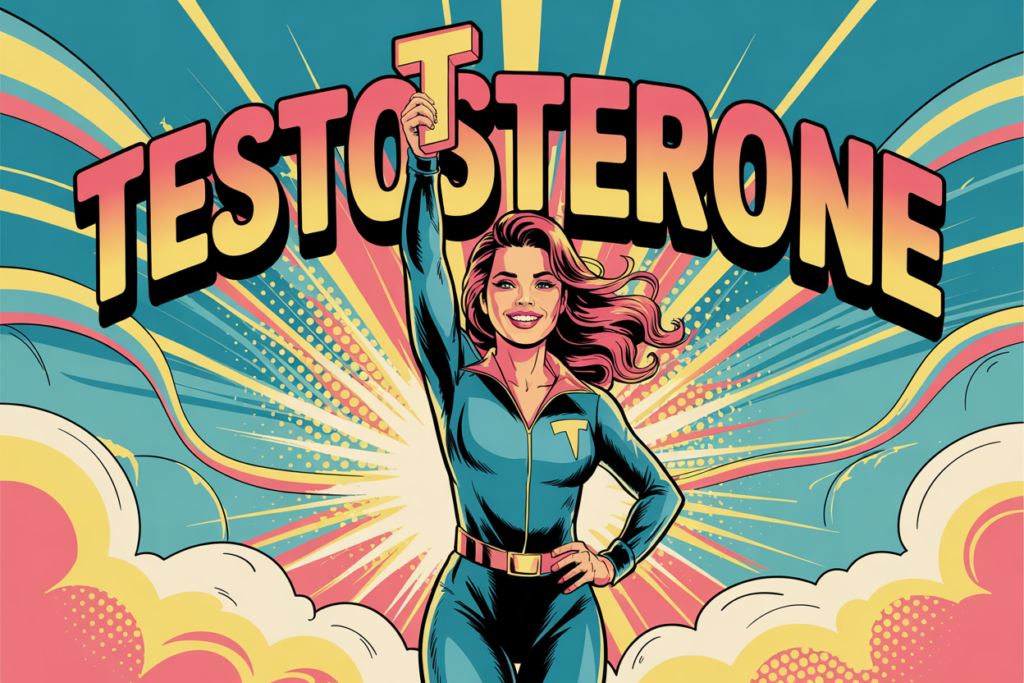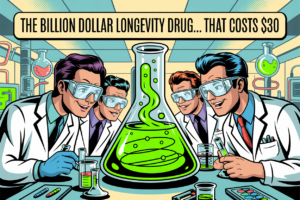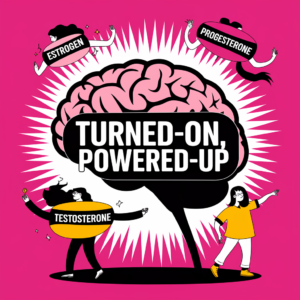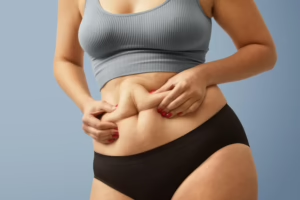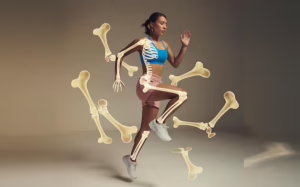Testosterone has gotten a bad rap as the “male hormone,” but that couldn’t be further from the truth. While men do have significantly higher levels, testosterone plays a critical role in women’s health and well-being, too. Far from being an unwelcome intruder, testosterone is the “take charge” hormone – the natural leader who turns every situation into an opportunity to excel.
Think of testosterone as that friend who suggests training for a marathon at brunch, turns every game night into a fierce competition, and has a “let’s make it happen” solution for every problem. In your body, testosterone is constantly optimizing and strengthening: building muscle mass, maintaining bone density, boosting energy levels, and keeping your confidence and libido ready for action.
Unlike estrogen’s nurturing “gather and tend” energy or progesterone’s calming “rest and digest” influence, testosterone is all about drive, performance, and results. She’s the Boss Babe of your hormonal system.
What Does Testosterone Do in Women’s Bodies?
Despite being present in smaller amounts than in men, testosterone performs numerous vital functions in women:
- Maintains muscle mass and strength – Without adequate testosterone, women experience muscle weakness and decreased strength
- Supports bone density – Works alongside estrogen to keep bones strong and prevent osteoporosis
- Fuels sex drive and arousal – The primary hormone responsible for libido in both men and women
- Enhances cognitive function – Supports focus, mental clarity, and cognitive performance
- Boosts energy and motivation – Provides that get-up-and-go feeling that helps you tackle challenges
- Improves mood and confidence – Contributes to feelings of assertiveness and emotional resilience
- Maintains skin and tissue health – Supports collagen production and tissue integrity
When Testosterone Goes High: Too Much of a Good Thing
Like any mighty force, testosterone needs balance. When levels climb too high (as in conditions like PCOS or certain adrenal disorders), you might notice:
- Excess facial and body hair growth – Testosterone turning up the volume on hair follicles
- Acne breakouts – When those oil glands get a bit too enthusiastic
- Increased muscle mass – The “go big or go home” approach to body composition
- Deepening voice – Testosterone restructuring vocal cords for maximum impact
- Aggressive or irritable moods – When that competitive drive goes into overdrive
- Irregular periods – Testosterone disrupting the usual hormonal dance
- Male pattern hair loss – When testosterone’s DHT cousin gets too ambitious with the scalp
When Testosterone Runs Low: The Energy Crisis
As women age, particularly around perimenopause and menopause, testosterone levels naturally decline. But many women experience low testosterone earlier due to various factors. When testosterone dips too low, you might experience:
- Fatigue and low energy – When your body’s power plant is running on low
- Decreased muscle mass and strength – The building blocks are taking an unwanted vacation
- Brain fog and difficulty concentrating – When your mental edge needs sharpening
- Low libido – The passion pilot light flickering low
- Depression and mood changes – When your emotional resilience takes a hit
- Weight gain, especially around the middle – The body’s energy efficiency is dropping
- Joint pain and decreased bone density – The Structural support system needs reinforcement
Understanding Testosterone Types and Testing
Testosterone doesn’t operate alone in your body. When we test testosterone levels, we’re looking at several important markers:
- Total Testosterone: This measures all testosterone in your bloodstream, both available and unavailable forms
- Free Testosterone: The unbound, biologically active testosterone that’s ready for action (usually only 1-2% of your total)
- SHBG (Sex Hormone Binding Globulin): A protein that binds to testosterone, making it inactive. When SHBG is high, less free testosterone is available
- Albumin: Another protein that loosely binds testosterone
Testing both total AND free testosterone gives the most accurate picture of your testosterone status. Many women have “normal” total testosterone but low free testosterone due to high SHBG levels, meaning they experience symptoms of low testosterone despite seemingly adequate levels.
Common Causes of Low Testosterone in Women
Low testosterone doesn’t happen in a vacuum. Several factors can contribute to declining levels:
- Age-related decline: Natural reduction that accelerates during perimenopause and menopause
- Stress and poor sleep: Chronic stress diverts hormonal resources away from testosterone production
- Excess body fat: Fat tissue converts testosterone to estrogen
- Medications: Including birth control pills, antidepressants, and statins
- Thyroid disorders: Hypothyroidism can decrease testosterone production
- Pituitary or adrenal issues: Since these glands influence testosterone production
- Insulin resistance Disrupts hormonal balance, including testosterone
- Chronic illness or inflammation: The body prioritizes survival over hormone optimization
When to Consider Testosterone Therapy
If you’re experiencing multiple symptoms of low testosterone (and especially if lab values confirm a deficiency), testosterone therapy might be worth exploring. According to the Global Consensus Position Statement on the Use of Testosterone Therapy for Women (2019), the primary indication for testosterone therapy is hypoactive sexual desire disorder (HSDD). However, many women also report improvements in energy, mood, cognitive function, and body composition.
In our next article, we’ll dive into the various options for testosterone therapy in women, including delivery methods, dosing considerations, and how to find the approach that works best for your unique needs. We’ll explore transdermal applications, vaginal options, pellets, injections, and more – with a practical breakdown of the pros and cons of each method.
Until then, if you suspect your testosterone levels might be low, consider asking your healthcare provider for testing. Remember to request both total AND free testosterone, as well as SHBG, to get the most accurate picture of your hormonal status.
Testosterone isn’t just for men – it’s the Boss Babe hormone that helps women thrive physically, mentally, and emotionally throughout their lives.
By Amy B. Killen, M.D.
Disclaimer: The information provided in this article is for educational purposes only and is not intended as medical advice. This content should not be used to diagnose or treat any health condition. Always consult with a qualified healthcare provider before making any changes to your treatment plan, medication, or lifestyle. Every individual’s body chemistry is unique, and hormone therapy must be personalized and supervised by a healthcare professional. The author is not responsible for any adverse effects or consequences resulting from the use of any suggestions, preparations, or procedures described in this article.
